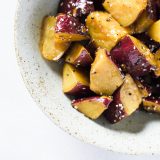In Autumn, the streets of Japan fill with a classic mix of aroma and melody, whiffs of sweet smoke wafting from passing vans accompanied by a singsong tune blasting on loudspeakers. “Ishi ya-aaaki imo-oooo!”
The effect is like an American ice cream truck, with children rushing to the streets for treats. But instead of novelty ice creams from the Good Humor truck, they are chasing down ishi yaki imo from the sweet potato man.
“We look forward to the season, just like chestnuts,” Nami Chen, author of the popular Japanese cooking blog Just One Cookbook, says of the sweet potatoes roasted on hot stones.
“There’s a nostalgic feeling for most Japanese. In the fall we go sweet potato harvesting, and I used to go when I was small for school field trips.”
In addition to ishi yaki imo, the firm, yellow-fleshed tubers—sweeter than the American orange variety—make it into numerous snacks, pastries and ice creams. Chen remembers bringing some home to her mother after visiting one of the many small farms around Yokohama where she grew up. She used them to make another fall favorite, deep-fried sweet potatoes with a crispy candy glaze.
They’re called daigaku imo, or university potatoes, possibly because they’re a cheap, filling snack many students have with an afternoon green tea, though the origin of the name has many theories. But they’re enjoyed as a sweet treat by all ages, sold in pop-up stands at festivals and premade in supermarkets everywhere.
The process is simple: deep-fry bite-size chunks of sweet potato while making a sugar syrup flavored with a small amount of soy sauce, the sweet rice wine mirin, and rice vinegar, which adds a hint of balancing tartness and helps prevent the syrup from crystallizing. Once the potatoes are brown and crunchy, they are tossed with the syrup and sesame seeds. The sweet-savory glaze hardens into a crispy shell that contrasts with the tender flesh inside.
We loved the bright flavor of the glaze, but we quickly ran into a problem: soggy sweet potatoes. Japanese sweet potatoes are starchier and denser than the typical American orange variety, which has a higher moisture content that makes crispy fried results challenging. When asked how she would adjust with an American potato, Chen demurred: “It would be tasty, but they wouldn’t get crispy, so they wouldn’t be daigaku imo.”
So at Milk Street, we didn’t try. Instead, we took our inspiration from the flavors rather than the textures. We simmered sweet potatoes with the seasonings until tender and coated with a savory-sweet glaze. Increasing the soy sauce and vinegar balanced the sweetness and moved this recipe toward a savory dinner side rather than a festival snack—and the bold flavors coating the tender potatoes were enough to make us feel we weren’t missing out.







